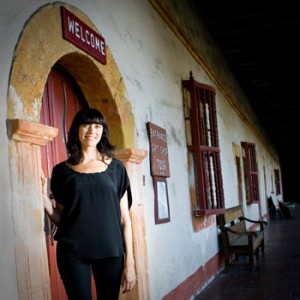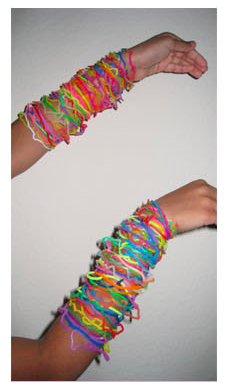
Shannon Turner Brooks of the Santa Barbara Conference & Visitors Bureau and Film Commission says the “really cool part of my job” is taking people out, “whether it’s for a travel TV show or just showing people around … I don’t think I ever have gotten over how pretty Santa Barbara is, just what a beautiful place it is.” (Elite Henenson / Noozhawk photo)
As Director of Communications for the Santa Barbara Conference and Visitors
Bureau and Film Commission, it’s Shannon Turner Brooks‘ business to talk-a
lot-about Santa Barbara. Here Noozhawk gives her the chance to talk-a
little-about herself, as well what’s going on at the CVB.
Leslie Dinaberg: Can you explain how the Conference and Visitors Bureau and
Film Commission is different from the Chamber of Commerce and the Downtown
Organization?
Shannon Turner Brooks: Essentially our mission is to market Santa Barbara as a
destination for tourism and film production. The simplest idea to convey is that
we bring people here who spend money in our community and then leave,
whereas I think the chamber is more about business development and people
moving here. Then we work with the Downtown Organization a lot like on
Epicure.SB (a 31-day, community-wide culinary extravaganza coming up in
October) (http://www.santabarbaraca.com/epicuresb/), that’s a good example of
our partnership. We collaborate with them on a regular basis.
LD: And film production is different than the film festival?
STB: It is. We get a lot of commercials, catalog shoots; photo shoots and then
feature films. “It’s Complicated” was one that was filmed recently, “Sideways,”
too, but we’re used more often for one day of shooting or getting a few scenes
here. Any kind of production like that, that would bring people in to use the
locations and then also use local services.
… The film commissioner, Jeff Alexander, … his job is basically connecting
people, whether it’s location scouts or producers, with the locations they need
and the resources and showing them what we have. So if they say, “I need a
Wild West saloon,” we say, “Here’s Maverick’s, that’s where you should go.”
LD: People always hear about “Sideways” or “It’s Complicated,” but I know there
are a lot of smaller things going on too.
STB: The bread and butter would be the commercials like car commercials and
fashion photography for catalogs. … Definitely more of the production is in North
County.
LD: That makes sense just because of the open space and it’s sort of different
looking. So can you explain your job a little?
STB: As director of communications I manage all of our public relations, so I’m
the primary media liaison and a big part of my job is working with travel and
lifestyle media from around the world to generate editorial coverage about Santa
Barbara. So I set up press trips, come up with story ideas and pitch Santa
Barbara. We put on media events; relationship building is a big part of that. We
put on a dinner in LA recently. The California Travel and Tourism Commission
they host media receptions in New York and LA and San Francisco so I
represent Santa Barbara at those and essentially I’m always telling people what’s
new and what’s going on in Santa Barbara.
Then we have press trips, so essentially I’ll work with the local community to set
up hotels and restaurants and whatever experiences or interviews they want to
get when they are here, and a lot of just meeting with the media and talking with
them and being a resource and a fact checker. It’s a lot of coming up with the
story ideas and what’s new. You’re a journalist so of course you know,
sometimes people will say, I’m looking for something on a romance theme or
green wineries or something like that.
LD: So it’s a lot of knowing everything that’s going on.
STB: Yes, keeping tabs on everything that’s going on and being creative and
also coming up with new ways to sell the destination. Like one example, this year
my big push in the winter was celebrate a century of cinema on the American
Riviera. … 2010 was the 100 year anniversary of filmmaking in Santa Barbara
and also at the same time “It’s Complicated” was going to be released Christmas
Day and then the film festival had its 25th anniversary, so I could package that as
one story and get that out. That ended up generating a story that went out on the
Associated Press Wire, the AP travel editor put that out and then “USA Today”
put a huge front of the travel section feature on that. I think we got over 100
placements just from that kind of idea, sort of creating that and then we had our
micro site where we put the content for that-people could go for itineraries and
then we did “It’s complicated” hotel packages and it was kind of creating things
that they can interact with, whether it’s the location they can go to or hotel
packages inspired by “It’s Complicated.”
LD: So the people who wrote the story for the AP, did you bring them to Santa
Barbara and host them?
STB: No. They don’t always do that. They didn’t come here for that. I’m trying to
think of an example of something that we actually hosted. “Golf Digest” came
here and they did this huge feature in the December issue and it was about wine
and golf so we used the “Sideways” story with that. We host about 70 travel
media every year. For the most part it’s print, although a lot of it is online now,
like the international travel TV shows they come through. We recently had
“GMTV,” which is kind of the British equivalent of NBC’s “Today Show.” Two of
their hosts came through on a Thelma & Louise-style road trip, so we set them
up with paddle surfing with Blueline and they stayed at San Ysidro Ranch and we
went to Alma Rosa Winery to kind of do the “Sideways” thing. It varies.
LD: Do you ever get weird requests from people wanting to do things?
STB: Occasionally there is an obscure request or I think sometimes a journalist
will send out a note to all of their PR contacts saying I’m looking for x, y and z
and we don’t have anything. But mostly it’s the other way around, that they are
surprised by certain aspects of Santa Barbara because a lot of people think of it
as kind of high end, luxury, celebrities and we have all these interesting aspects
to our culture, like I just did a promotion of the green environmental aspect and
the food and wine has been really big lately. I think more often than not it is
pleasantly surprising when people look at all that Santa Barbara has to offer.
LD: How did you get into this kind of work?
STB: I went to UC San Diego and I studied communications there and my last six
months there I had gotten an internship through school at a magazine. (After
that) I moved to Santa Barbara because I grew up in Lompoc and I always loved
the area … I had originally looked for jobs with magazines, in publishing, and as
you know, it’s not a very big media market as I quickly discovered. I think it was
actually my mother who saw this ad for the visitor’s bureau. It was actually for an
administrative assistant, so I probably wouldn’t have looked at it, but the
description of it was interesting with the travel and the marketing and the film, so
I applied for it. … It ended up being a marketing coordinator. … That was ten
years ago in July that I’ve actually been with the visitor’s bureau fresh from
college.
LD: Obviously your responsibilities have changed; do you think anything has
changed significantly in terms of what’s going on in Santa Barbara in the last ten
years?
STB: It’s been interesting to see more of the changes of our product. We’re
always looking for what’s new and so seeing the evolution as new businesses
come up. Our wine industry has exploded. I think when I started we were at six
wineries and now it’s like 175. And I was really involved in the “Sideways”
marketing campaign and that was really interesting to see the effect, which we
are still seeing people from the press that are interested in that angle.
LD: What else do you do when you’re not working?
STB: I do love to travel. I love travel and I always have to have a trip in my mind
whether it is a weekend getaway to San Francisco or an international
adventure.
LD: What’s on your mind right now?
STB: Well I’m going to go to Treebones in Big Sur at the end of this month with
my childhood friends. We have an annual get together and there are five of us six
of us.
LD: Are you going to stay in the yurts?
STB: We are actually upgrading to the yurts because typically we’ve gone
camping and we’ve decided we’re grown up so yeah, we’re splurging on the
yurts. … I’m also going to North Carolina … and I’m going to Sardinia next May.
… Then I love to eat and drink, of course. (Laughs)
LD: You have a good job for that.
STB: I get to do a lot of that for my job. Everything I know about wine I’ve learned
from my job, from just taking journalists out to the wineries and meeting with
winemakers or working with them on our events. I really enjoy that part very
much. I’m very lucky to have the talented winemakers that we have. I just think
it’s so pretty to go up into the wine country.
LD: So are you professionally obligated to try out any restaurant that opens
up?
STB: I try to. (Laughs). We have a new blog actually, which has been fun. I’m
trying to do a weekly post. That’s been nice to give me something else that’s a
way to talk about what’s new aside from just my newsletter that I do.
LD: There’s such a high interest in that.
STB: Santa Barbara is a small town but it’s very food-oriented, so anytime there
is something new it is very exciting. So yes, I try to keep up on that. I am a
vegetarian so sometimes I write about things that I don’t actually eat but I
appreciate all of the local sensibilities. I’m not a moral vegetarian so I think
people should eat what their body tells them to eat. I like to do yoga, I love the
beach, all the fun Santa Barbara things: hiking, beaches, yoga, seeing family and
friends. There isn’t really time for much else. I do like to read and I read a
lot.
LD: If you could pick three adjectives to describe yourself, what would they
be?
STB: Tall (Laughs), calm, I’m very calm and easygoing.
LD: Do you have a favorite local spot?
STB: I feel like with my job that’s a dangerous question politically. I don’t think
anyone to hold that against me. … I do think that Casa Del Hererro is
spectacular and I would like to live there. I love the old Santa Barbara vibe. San
Ysidro Ranch is quite stunning as well. That’s another place I would like to live.
The courthouse, the view from the clock tower, which is where I send all of our
visitors and our media there and when I have friends come to town I usually take
them there for the proper tourist photo. It’s special.
LD: You probably get to do more of that kind of stuff than most people do.
STB: That’s true. It’s a really cool part of my job taking people out, whether it’s for
a travel TV show or just showing people around, it’s always nice to see things
through fresh eyes and how beautiful it is and how much they appreciate it. I
don’t think I ever have gotten over how pretty Santa Barbara is, just what a
beautiful place it is.
Vital Stats: Shannon Turner Brooks
Born: February 11, in San Francisco, CA. Grew up in Lompoc.
Family: “I’m not married, my mom’s always looking for a husband for me.”
Parents are retired teachers living in Lompoc (mom is county planning
commissioner Marell Brooks), plus a brother, sister-in-law and nephew in Santa
Barbara and another brother in Monterey.
Civic Involvement: Downtown Organization’s Cultural Committee, Board Member
of the Performing Arts League.
Professional Accomplishments: “I appreciate being able to help all these different
local businesses promote their success … that’s really the point of our
organization is to promote the community and bring in tourism tax dollars. It’s
very much a people-oriented job. We work with all of these local companies and
it’s great to be able to help them in any way that we can.”
Best Book You’ve Read Recently: “To Kill a Mockingbird” by Harper Lee, “The
Bone People” by Keri Hulme and “The Elegance of the Hedgehog” by Muriel
Barbery.
Little-Known Fact: “I’m addicted to music. I really love music and all day long I
listen to Pandora radio.”
Originally published in Noozhawk on August 29, 2010. Click here to read the story on that site.






